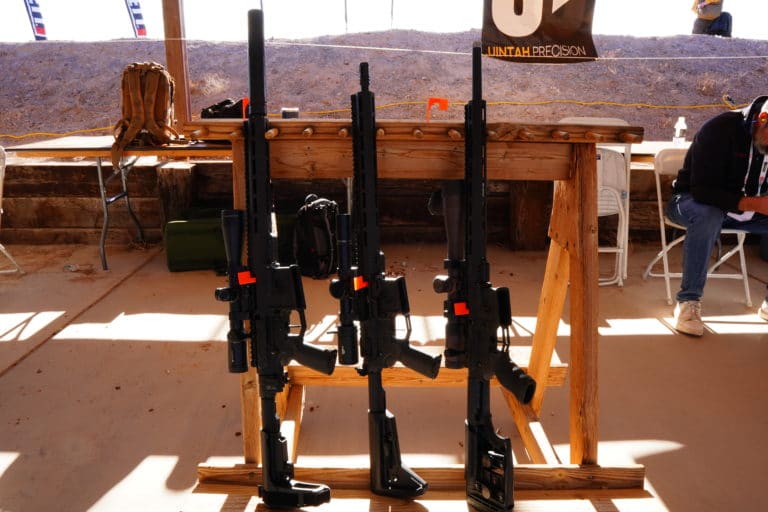State-level “assault weapon” bans have returned with a bang, achieving new victories in ways not seen in more than two decades. Yet shifts in public opinion and the Supreme Court’s watchful eye mean their days may be numbered.
On Tuesday, Illinois officially became the ninth state in the country to pass a ban on certain semi-automatic firearms commonly referred to by gun-control advocates as assault weapons. The ban, already signed and in effect, outlaws over 170 rifles, pistols, and shotguns by make and model and provides open discretion to the Illinois State Police to add weapons to the prohibited list “as needed.” Owners of the newly-banned guns will be allowed to keep them so long as they possess an active Firearm Owners Identification (FOID) card and register the guns with police.
The ban is significant because it makes Illinois the second state in less than a year to pass a new assault weapon ban—Delaware passed the other last summer. But what’s more significant is that the two laws together represent the first new states to pass bans in more than 20 years.
And more bans may be coming soon.
Outside of Illinois, state lawmakers in Washington state and Colorado have announced proposals for their own statewide assault-weapon bans to be introduced sometime this year. If both are successful, that will represent the largest outbreak of new weapons bans since the 1990s when assault weapon bans were at their political zenith.
California started the trend in 1989, becoming the first state in the country to place a ban on what it considered to be assault weapons. New Jersey followed with a ban of its own a year later. Then, between 1992 and 1998, Hawaii, Connecticut, Maryland, and Massachusetts passed bans of varying stringency (Hawaii and Maryland’s ban dealt with “assault pistols,” for example). Finally, New York rounded out the decade by finalizing its first assault weapon ban in 2000.
Most of these states have subsequently expanded their bans, particularly in the mid-2010s following the Sandy Hook massacre. But until 2022, that was the only serious movement in the country on assault weapon ban legislation. With two new states added to the list, and two more with a real possibility of passing a new ban, it’s undeniable that gun-control advocates have some serious momentum behind them heading into 2023.
At the same time, two significant trends stand to blunt the impact of the gathering momentum behind the burgeoning assault weapon ban push. The first is that the bans are becoming less popular while the weapons they attempt to regulate continue to get more popular.
A June 2022 Quinnipiac University poll conducted in the immediate aftermath of the Uvalde school shooting found that the fewest registered voters supported an assault weapons ban since Quinnipiac first began asking the question in 2013. Just one month later, the same pollster found that support for the ban had dropped yet again, dipping below 50 percent support for the first time ever.
Meanwhile, the revealed preferences of the American public’s gun purchasing habits suggest that so-called assault weapons are more popular than ever. A 2022 estimate from the National Shooting Sports Foundation (NSSF) found that there are at least 24.5 million AR-15s, AK-47s, and their derivatives in civilian hands nationwide. Likewise, the 2021 National Firearms Survey conducted by Georgetown University professor William English found that “30.2% of gun owners, about 24.6 million people, indicated that they have owned an AR-15 or similarly styled rifle.”
The other force that stands to work against this renewed assault weapon push is the U.S. Supreme Court. Its decision in New York State Rifle & Pistol Association v. Bruen and the heightened Second Amendment test it established is undoubtedly the elephant in the room for any ongoing question surrounding the viability of new assault weapon bans.
Two Colorado municipal assault weapon bans have already been blocked under the Bruen test in federal court by judges who ruled that they likely violated the constitution. And the Supreme Court itself has made moves casting doubt on the legality of the bans.
Shortly after issuing its decision in Bruen, the court vacated Federal appeals court rulings upholding Maryland’s assault weapon ban and magazine bans in California and New Jersey. It then ordered the lower courts to rehear those cases with the new Bruen test in mind. It seems unlikely that the court would have decided to go that route if it was inclined to agree with the outcome reached initially in those cases. Bolstering that point is that at least one sitting justice has explicitly called assault weapon bans unconstitutional previously in an official legal opinion as a D.C. Circuit Court judge.
That all makes states deciding now is the prime moment to push for new bans especially confusing. Declines in polling support and increased public ownership of the weapons may not put policymakers off the policy, but the Bruen decision and its implications for mounting a viable legal defense against inevitable legal challenges is a reality that’s more difficult to ignore.
But losing a court case against the new bans may not be much of a deterrent. Politicians always have the option of pointing the finger at the Supreme Court for upending a policy their constituents may still find appealing.
It certainly wouldn’t be the first time such a tactic was employed. Governments in blue cities within red or purple states, such as Philadelphia, routinely pass gun control laws they know to be unconstitutional or illegal under state law. Then, once those laws are invariably struck down, they allow the courts or state legislators to be the foil for why we can’t have nice things.
The Supreme Court may have to step in and offer a definitive ruling on the bans to stop their resurgence, at least in deep blue states. But even that may not be enough.
That’s because, despite the declining public support for assault weapon bans, there are sizeable enough constituencies that support the policy in many places. That’s particularly true in Democratic strongholds like Illinois. So, it’s likely passing new bans without regard for the Supreme Court’s guidance will continue to be popular.







Only Members can view comments. Become a member today to join the conversation.